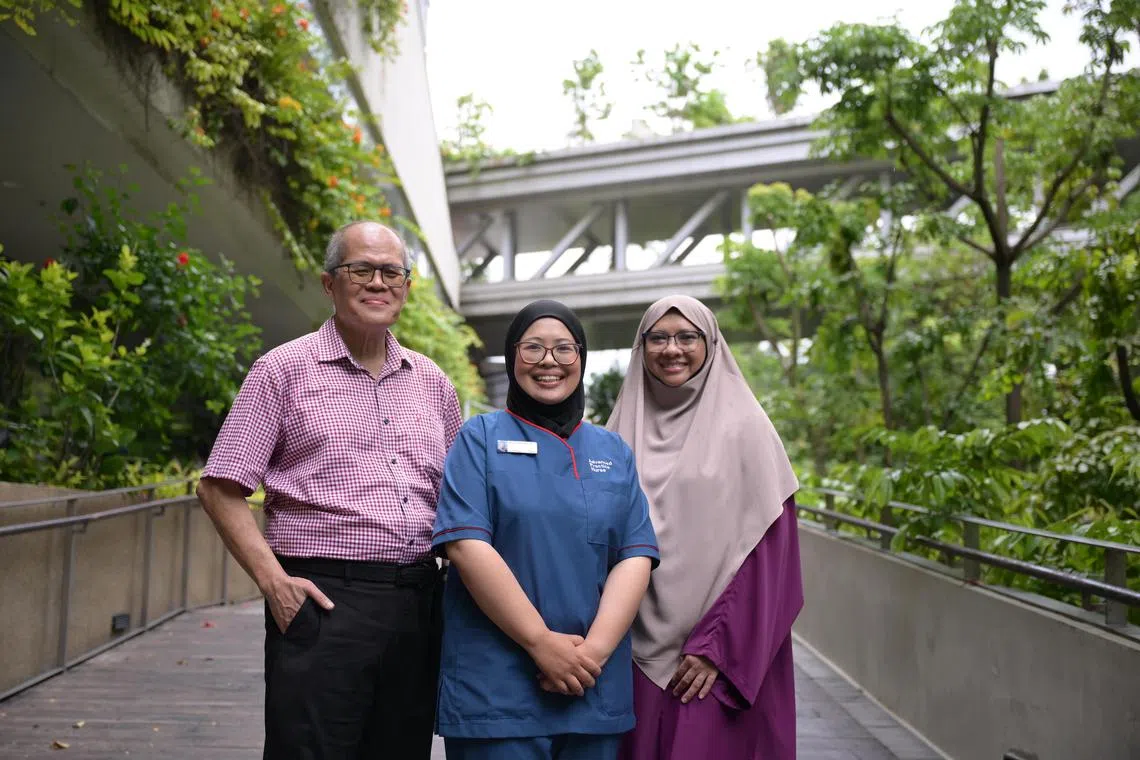Khoo Teck Puat Hospital programme supports diabetic Muslims on haj and umrah
Sign up now: Get ST's newsletters delivered to your inbox

Diabetic patients Mohamed Ismail Ibrahim (left) and Faiza Sanip (right) alongside Khoo Teck Puat Hospital nurse clinician Mariana Mahadi.
ST PHOTO: NG SOR LUAN
Follow topic:
- KTPH nurse Mariana Mahadi noticed a rise in diabetes complications among Muslim pilgrims post-haj/umrah, prompting research and a tailored programme.
- The Group Education & eMpowerment programme offers medical and religious guidance, equipping pilgrims with skills for medication, diet, foot care and blood sugar management.
- After attending the course, Madam Faiza Sanip and Mr Mohamed Ismail Ibrahim, who both have diabetes, gained both confidence and practical knowledge.
AI generated
SINGAPORE – For many Muslims, the pilgrimage of haj or umrah is the spiritual journey of a lifetime. For those with diabetes, however, these sacred trips can pose serious health challenges.
In 2021, Ms Mariana Mahadi, an advanced practice nurse and nurse clinician at Khoo Teck Puat Hospital’s (KTPH) Advanced Practice Nurses & Specialty Nurses Department, noticed a worrying trend.
“I observed an increasing number of patients being hospitalised or developing diabetes complications after going on umrah and haj,” she says, without giving specific figures.
She reviewed medical research and confirmed that this issue was not unique to Singapore, but was happening worldwide. Many pilgrims faced difficulties managing diabetes while juggling the physical and spiritual demands of haj and umrah.
Umrah and haj are Islamic pilgrimages to the holy city of Mecca in Saudi Arabia. They are sometimes held during periods of intense heat, with temperatures that can exceed 50 deg C, making it a physically demanding experience.
The main difference is that the haj takes place only once a year, during a specific period in the Islamic calendar. The umrah can be done at any time of the year, except during the haj period.
Health risks on the journey
One of the key issues Ms Mariana identified among patients was a lack of knowledge in diabetes self-care during travel. This is particularly true for pilgrims, who often face significant changes to their daily routines due to differences in geography, climate, diet and lifestyle.
Some of the common challenges they face include hypoglycaemia (low blood sugar), hyperglycaemia (high blood sugar), infections, foot complications and dehydration.
One case, Ms Mariana recalls, particularly highlighted the need for tailored guidance. A 48-year-old woman, whose diabetes was poorly controlled, sustained a foot injury just before an umrah in 2023. She initially sought treatment from a general practitioner in Singapore and was prescribed oral antibiotics.
During the umrah, the condition of her foot worsened due to extensive walking, sometimes barefoot, as required by the ritual. She sought medical attention in Saudi Arabia, where she was again prescribed oral antibiotics. Unfortunately, the wound continued to deteriorate.
“Upon returning to Singapore, she faced possible amputation. Through careful medical management, close monitoring and lifestyle adjustments, her foot was ultimately saved – a recovery that took several months,” says Ms Mariana.
Recognising such instances, she conceptualised a pioneering programme called the Group Education & eMpowerment (GEM): Haj/Umrah Edition in November 2023, with support from a team of healthcare professionals.
The programme, delivered at KTPH’s Diabetes Centre at Admiralty Medical Centre, is run by a multidisciplinary team that brings together doctors, nurses, dietitians, physiotherapists and podiatrists.
According to Ms Mariana, this is Singapore’s first public healthcare programme tailored for pilgrims with diabetes.
The four-hour programme, which costs $69.20 (excluding GST), combines medical advice with religious and cultural insights, providing practical guidance for the challenges pilgrims face.
Understanding what patients will experience is crucial, says Ms Mariana, so the team holds sessions led by a religious teacher to explain the requirements of the rituals.
“This helps everyone, especially those who have not been on pilgrimage, to gain a clearer perspective,” she adds.
Participants learn how to pack appropriately for the journey, manage medications in a hot climate, monitor their blood sugar levels while observing sacred rituals, and maintain foot care despite walking barefoot.
“We incorporate more hands-on activities, practical lessons and sharing sessions, rather than relying solely on traditional lectures,” says Ms Mariana.
Launched in 2024 after a successful 2023 pilot, the programme has so far held four sessions in total, equipping about 40 participants aged 30 to 70 with health management skills.
Gaining confidence through preparation
For 56-year-old Madam Faiza Sanip – who has diabetes, high blood pressure and high cholesterol, and suffered a stroke in 2023 – the programme came at the right time.
She had been preparing to perform the haj in June, but had concerns about whether her health would hold up during the physically demanding rituals.
“I was worried. Because of my stroke, my right side is weaker. I didn’t want to burden my family or fall sick while I was there. What if I got another stroke during haj? These were the thoughts that played in my mind,” says Madam Faiza, who is married and has six children aged 21 to 31.

Madam Faiza Sanip (left) with her sister-in-law, Madam Rahayu Mohamad, performing the haj in Mecca, Saudi Arabia, in June.
PHOTO: COURTESY OF FAIZA SANIP
Her diabetes doctor at Admiralty Medical Centre recommended the programme.
“He encouraged me to attend, saying it was holistic. It’s not just about managing diabetes but also about exercise, water intake, medication and practical things like not putting my pills in my checked luggage.
“I was very grateful because it prepared me both medically and spiritually,” she says.
Madam Faiza, a programme manager in the mental healthcare industry, recalls how detailed the programme was.
“The nurses mapped out the pilgrimage journey ritual by ritual, showing us how to take care of ourselves at each stage. The podiatrist checked our feet and advised us on footwear. I was told to make sure my shoes were 1cm bigger, not tight-fitting, and to moisturise (my feet) regularly because of the hot, dry climate,” she says.
This advice proved vital.
During the haj, she developed a painful callus on her foot.
“Because of what I learnt, I was very mindful. I moisturised my feet several times a day and reminded my roommates to do the same. Many pilgrims cut their feet because they walk barefoot or without socks. I knew that for someone with diabetes, that could be dangerous. So, I shared the advice with others,” she says.
Madam Faiza also used a continuous glucose monitor, which her doctor could track remotely. The monitor is small and tracks a person’s blood sugar levels throughout the day and night.
“It gave me peace of mind to see my sugar levels in real time. Even when they spiked due to stress or fever from the 46 deg C heat, the doctor reassured me I was still in a safe range,” she says.

Madam Faiza Sanip performing the haj in Mecca, Saudi Arabia, in June.
PHOTO: COURTESY OF FAIZA SANIP
Diet was another challenge. Haj accommodation often comes with at least two buffet meals a day. “It’s easy to overeat,” she says. “But the programme reminded me of portion control, to eat more protein and less carbs, and to stay hydrated.
“I learnt that if I’m dehydrated, my sugar level will spike. So, I drank water regularly, even though it was sometimes inconvenient because there weren’t toilets nearby.”
The physical training she received also made a difference.
“The physiotherapist showed us exercises to strengthen our legs and core. I also trained with a personal trainer friend before haj to correct my gait. During haj, I walked 5km to 7km almost every day, sometimes with a walking stick on uneven ground. But I managed,” she says.
Retiree Mohamed Ismail Ibrahim, 67, says the course has been crucial preparation.
The father of three was supposed to attend umrah with his wife at the start of 2025, but had to postpone the trip after she injured her leg. They plan to make the pilgrimage together at the end of the year.
Mr Ismail – a former environmental health, safety and security manager in a beverage company – first heard about the programme from his doctor. “I feel enlightened because the programme gave me the information I need – what to do to prevent myself from getting injured, and how to take my medication so that I remain healthy during the pilgrimage,” he says.

Mr Mohamed Ismail Ibrahim says the course has highlighted important information, including managing his blood sugar level during long hours of praying and walking.
ST PHOTO: NG SOR LUAN
The programme taught him practical skills such as how to pack insulin and keep it at the right temperature, and how to manage his blood sugar level during long hours of prayer and walking.
When he went for his first haj in 1991, he did not have diabetes. Now, living with the condition, he says: “After going through the programme, I have the confidence that I can manage.”
Support beyond the journey
The team behind the programme also conducts follow-ups.
They track the return dates of pilgrims and call them about two weeks after their arrival.
“During the call, we ask about their pilgrimage experience, whether they were able to manage the challenges they faced, and if they required any hospital admissions or medical consultations while in Saudi Arabia,” says Ms Mariana.
These conversations, she says, help to evaluate the effectiveness of the programme and identify areas the team may have overlooked or need to improve upon.
Looking back, Madam Faiza says the programme gave her confidence in completing her pilgrimage.
“It helped me focus on my spiritual journey instead of worrying about my health. It gave me peace of mind, because I knew how to manage my diabetes and what to do if something went wrong. I realised that even with a chronic illness, you can perform haj well if you take the right steps to prepare.”
She encourages others with diabetes not to be deterred.
“Don’t think you cannot perform haj just because you have diabetes. Make sure your condition is under control, attend your check-ups, take your medication, exercise regularly and prepare well. With guidance, it is possible.”


